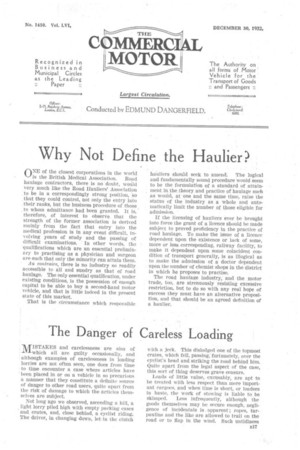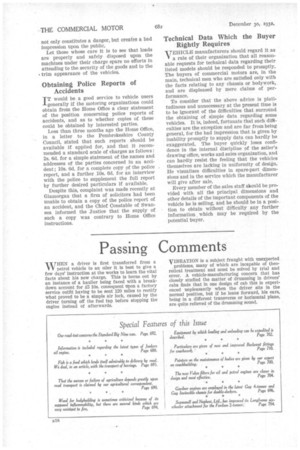The Danger of Careless Loading
Page 31

Page 32

If you've noticed an error in this article please click here to report it so we can fix it.
AITISTAKES and carelessness are sins of -Iv-I-which all are guilty occasionally, and although examples of carelessness in loading lorries are not often seen, one does from time • to time encounter a case where articles have ' been placed in or on a vehicle in so precarious a manner that they constitute a definite source of danger to other road users, quite apart from the risk of damage to which the articles themselves are subject.
Not long ago we observed, ascending a hill, a light lorry piled high with empty packing cases and crates, and, close behind, a cyclist riding. The driver, in changing down, let in the clutch with.a jerk. This dislodged one of the topmost crates, which fell, passing,lortunately, over the cyclist's head and striking the road behind him. Quite apart from the legal aspect of the case, this sort of thing deserves grave censure.
Loads of little value, excusably, are apt to be treated with less respect than more important cargoes, and when time is short, or loaders in haste, the work of stowing is liable to be skimped. Less infrequently, • although the goods themselves may be secure enough,' negligence of incidentals is apparent ; ropes, tarpaulins and the like are allowed to trail on the road or to flap in the wind. Such untidiness not only constitutes a danger, but creates a bad Impression upon the public.
Let those whose care it is to see that loads are properly and safely disposed upon the machines under their charge spare no efforts in attending to the security of the goods and to the trim appearance of the vehicles.
Obtaining Police Reports of Accidents
TT would be a good service to vehicle users -I-generally if the motoring organizations could obtain from the Home Office a clear statement of the position concerning police reports of accidents, and as to whether copies of these could be obtained by interested parties.
Less than three months ago the Home Office, in a letter to the Pembrokeshire County Council, stated that such reports should be available if applied for, and that it recommended a standard scale of charges as follows : 2s. 6d. for a simple statement of the names and addresses of the parties concerned in an accident; 10s. 6d. for a complete copy of the police report, and a further 10s. 6d, for an interview with the police to supplement the full report by further desired particulars if available.
Despite this, complaint was made recently at Glamorgan that a firm of solicitors had been unable to obtain a copy of the police report of an accident, and the Chief Constable of Swansea informed the Justice that the supply of such a copy was contrary to Home Office instructions.
Technical Data Which the Buyer Rightly Requires
-VEHICLE manufacturers should regard it as V a rule of their organization that all reasonable requests for technical data regarding their listed models should be responded to promptly. The buyers of commercial motors are, in the main, technical men who are satisfied only with the facts relating to any chassis or bodywork, and are displeased by mere claims of performance.
To consider that the above advice is platitudinous and unnecessary at the present time is to be ignorant of the difficulties that surround the obtaining of simple data regarding some vehicles. It is, indeed, fortunate that such diiiiculties are the exception and are far from being general, for the bad impression that is given by inability promptly to supply data can hardly be exaggerated. The buyer quickly loses confidence in the internal discipline of the seller's drawing office, works and sales organization, and can hardly resist the feeling that the vehicles themselves are lacking in uniformity of design. He visualizes difficulties in spare-part dimensions and in the service which the manufacturer will give after sale.
Every member of the sales staff should be provided with all the principal dimensions and other details of the important components of the vehicle he is selling, and he should be in a position to obtain without difficulty any further information which may be required by the potential buyer.




























































































